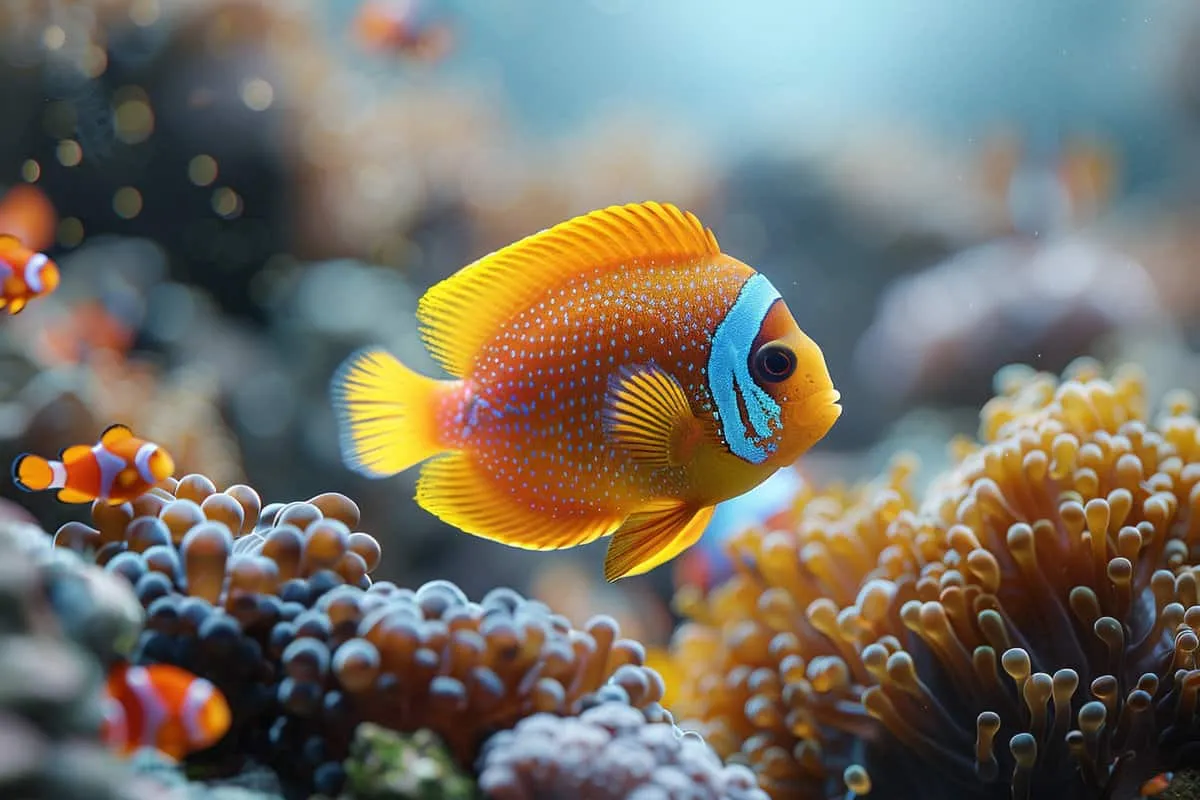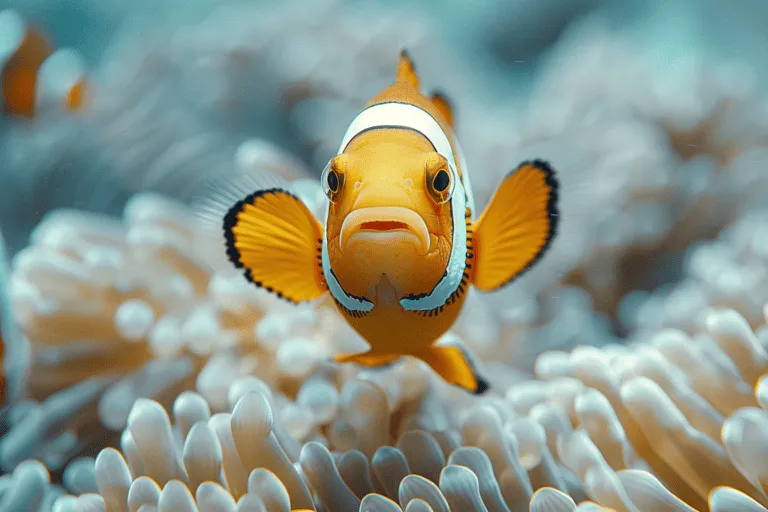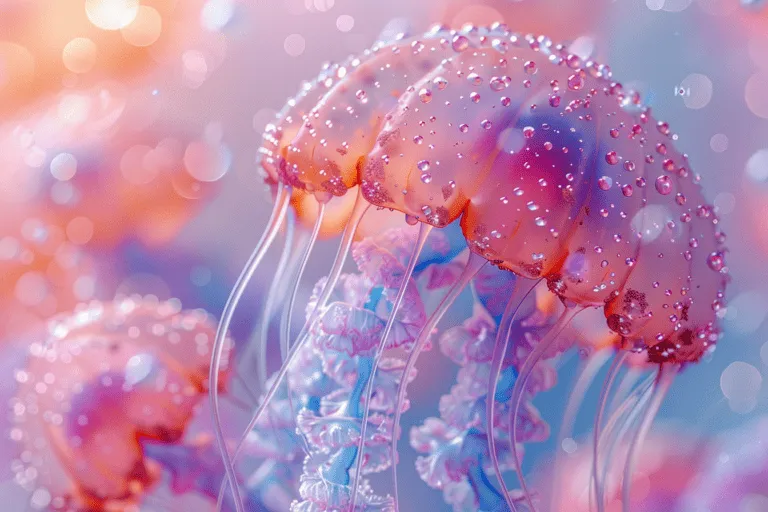Tropical Fish Facts: 10 Surprising Insights Under 60 Characters
Dive into the vibrant world of tropical fish, where colors burst like underwater fireworks and each fin flick tells a story.
These aquatic marvels bring the ocean’s hidden tales right to our tanks, showcasing nature’s artistry beneath the waves.
From their kaleidoscope patterns to their intriguing behaviors, tropical fish are more than just pets; they’re living pieces of art that swim against the current of ordinary life.
Ready to explore some jaw-dropping facts about these underwater treasures? Keep scrolling as we unveil reviews of our top picks in the realm of tropical fish facts.
1. Parrotfish Sleep in Bubbles
At night, parrotfish do something remarkable for protection—they produce a mucus bubble. This isn’t just any bubble; it’s a superpower against predators! The bubble hides their scent, making it hard for predators to find them.
Why do they go through all this trouble? It’s all about survival and helping coral reefs stay healthy.
When parrotfish sleep safely, they wake up ready to munch on algae. Eating algae is crucial because too much of it can harm coral reefs.
Coral reefs are like underwater cities full of life. They’re home to thousands of species, including the colorful parrotfish.
By keeping algae in check, parrotfish ensure that these habitats remain vibrant and full of food for other sea creatures.
People often admire these fish in aquariums without knowing their nighttime routine or how important they are to ocean ecosystems.
Watching a parrotfish snooze in its bubble might be tricky unless you’re diving at night! But understanding their role shows us how every creature has its part in maintaining the balance underwater.
2. Clownfish Can Change Gender
Clownfish are fascinating creatures that start their lives as males. But here’s the twist: they can switch to become females. This change is not just a whim; it’s essential for their survival and leadership within their group.
The ability of clownfish to change gender is closely tied to the social structure of their groups, known as schools. In these schools, there’s always a dominant female.
If she disappears or dies, the most dominant male steps up, changing its gender to become the new leading female.
What makes this transformation even more interesting is that once a clownfish changes into a female, it cannot go back to being a male. This one-way street ensures there’s always a balance in the social hierarchy of their community.
This unique trait among clownfish showcases nature’s incredible adaptability and complexity. It highlights how animal behaviors and physical changes can be driven by social needs and survival strategies.
3. Mandarinfish Have No Scales
Mandarinfish are unique in the marine fish world because they don’t have scales. Instead, their skin is smooth and produces a special kind of mucus.
This isn’t just any mucus; it’s smelly! But there’s a good reason for that smell. It helps keep predators away by making the mandarinfish less appealing to eat.
Not only does this mucus serve as protection, but these fish are also known for their incredible beauty. Their vivid colors light up the reef like a neon sign, making them one of the most beautiful fish you can find underwater.
The mix of bright blues, oranges, and greens on their bodies isn’t just for show—it’s nature’s way of saying “back off” to potential threats.
However, being scale-less has its downsides too. Without scales to shield them, mandarinfish are more open to diseases and parasites than other salt water creatures. This makes their stunning appearance a bit of a double-edged sword.
Despite these vulnerabilities, mandarinfish thrive in their natural habitats thanks to cleaner fish who help by eating harmful parasites off their bodies.
4. Seahorses Are Monogamous
Seahorses have a unique approach to relationships. They pair up for life, engaging in intricate courtship dances that strengthen their bond.
This dance is not just for show; it’s a vital part of how they connect with each other.
What sets seahorses apart even more is the role reversal. In this species, males carry the pregnancy and give birth, which is rare in the animal kingdom.
This unusual trait highlights the depth of their partnership, as male seahorses take on a significant responsibility in ensuring the continuation of their lineage.
Another fascinating aspect of seahorse relationships is how they recognize their partners among many. They use distinct body vibrations to identify each other.
This means that even in crowded environments or after being separated, they can find their way back to their partner using these unique signals.
This level of fidelity and connection makes seahorse relationships truly remarkable within marine life.
5. Electric Eels Aren’t Actually Eels
Despite their name, electric eels are not true eels at all. They belong to the knife fish family. This is a fun fact that surprises many people who assume they’re closely related to the eels we see slithering in the ocean.
Electric eels have an astonishing ability to generate electric shocks of up to 600 volts. Imagine that! It’s like having a living power socket in water.
This powerful shock is used for both hunting and self-defense, making them one of the most electrifying predators in freshwater habitats.
They use this electricity in an interesting way. For hunting, they send out low-level electric pulses to locate their prey. Once found, they unleash a high-voltage shock that stuns or kills their target instantly before gobbling it up.
For self-defense, the mere knowledge among other animals that electric eels can produce such a shocking experience keeps many potential threats at bay.
It’s nature’s own version of keeping your friends close and your enemies electrocuted!
6. Angelfish Can Recognize Themselves in Mirrors
Angelfish have a unique ability that sets them apart from most fish species. They can pass the mirror test, which is often used to indicate self-awareness.
This means when they see their reflection, they don’t think it’s another fish; they recognize it as themselves.
This skill is not just for show. Angelfish use mirrors to check their bodies for parasites and other issues that might be hard to spot without a reflective surface.
Not many fish species demonstrate this level of intelligence. The fact that angelfish can do this suggests they have a higher cognitive function compared to others in the aquatic world.
Imagine having such keen awareness of your surroundings and yourself that you could spot even the tiniest change on your body without anyone pointing it out to you. That’s pretty much what angelfish are doing under the water, using nature’s mirror.
7. The Blue Tang Undergoes Dramatic Color Changes
The vibrant colors of the Blue Tang, a popular tropical fish found in tropical waters, tell an amazing story of transformation and adaptation.
As juveniles, these fish start with a bright yellow coloration. This is nature’s way of blending them into their environment for protection.
As they grow older, they undergo a stunning change to blue. This isn’t just any blue; it’s a vivid hue that captures the essence of tropical seas.
This color change signals their maturity and readiness to join the adult population.
But there’s more to their color than meets the eye. At night, Blue Tangs turn pale or white. This nighttime camouflage helps them stay hidden from predators while they rest among the reefs.
Interestingly, changes in color can also indicate how a Blue Tang is feeling. Stress or illness often causes them to lose their vibrant colors temporarily—a clear sign that something isn’t right in their world.
These shifts are influenced by various factors including light, temperature, and even UV light exposure which plays a crucial role in maintaining their brilliant hues.
8. Pufferfish Inflate as a Defense Mechanism
Pufferfish are fascinating creatures, especially. When they sense danger, they can inhale water or air to expand their size dramatically.
This sudden increase in size makes them look more intimidating to potential predators.
What’s even more interesting is that their spines, which are normally not visible, become prominent and stick out when they puff up.
These sharp spines act as an additional deterrent, making predators think twice before trying to snack on a puffed-up pufferfish.
However, this incredible ability comes with its own set of risks. Inflating too often can be harmful to the pufferfish.
Each time they puff up, it puts stress on their bodies and can lead to health issues if done excessively.
Despite these risks, the ability to inflate is a vital survival tool for pufferfish. It’s a clear example of how animals have evolved unique adaptations tailored specifically for protection against threats in their environment.
9. Guppies Can Give Birth to 50 Babies at Once
Guppies are fascinating creatures, especially. Female guppies have a unique ability to store sperm from a single mating session.
This means they can give birth multiple times without needing to mate again.
Under the right conditions, which include warm water and plenty of food, female guppies can give birth about every month.
Imagine that! A new batch of baby guppies every 30 days or so.
What’s even more astonishing is the number of babies they can produce at one time. Up to 50 tiny, fully formed guppies might emerge, ready to swim and fend for themselves immediately after being born.
This reproductive strategy has some clear advantages:
- It ensures a high survival rate by overwhelming predators with sheer numbers.
- It allows female guppies to spread their genes widely across many offspring.
- The capacity for females to store sperm reduces the need for frequent mating, which could expose them to predators or other dangers.
10. The Royal Gramma Can Swim Backwards
The Royal Gramma, a vibrant fish found in tropical waters, has an incredible ability to swim backwards.
This unique skill is not just for show; it serves a practical purpose.
When danger approaches, the Royal Gramma can quickly retreat into the safety of crevices and small spaces among coral reefs.
Its bright purple front and yellow back are more than just attractive colors. These hues help the fish blend seamlessly with its surroundings, making it harder for predators to spot them among the colorful corals.
These fish have a preference for living on vertical surfaces and under overhangs within their habitat. Such areas offer protection and a strategic advantage for spotting food or threats from different angles.
It’s like choosing the best seat in class where you can see everything clearly without being too noticeable—a smart move!
Frequently Asked Questions
How do parrotfish sleep?
Parrotfish create a protective bubble around themselves to sleep. It’s like their own cozy, little bubble blanket that keeps them safe from predators at night.
Can clownfish really change gender?
Yes, clownfish are quite the shape-shifters! If the female in their group passes away, a male can transform into a female to take her place. It’s nature’s way of keeping the party going.
Why don’t mandarinfish have scales?
Mandarinfish skipped the scale line and went straight for slime. They’re covered in a slimy mucous instead of scales, which helps keep parasites and infections at bay—a real-life superhero suit!
Are seahorses faithful to one partner?
Seahorses are true romantics; they mate for life. These monogamous creatures perform daily rituals with their partners, proving that love is indeed deep in the sea.
Why aren’t electric eels considered real eels?
Despite their name, electric ‘eels’ are more closely related to catfish than they are to actual eels. It’s like finding out your distant cousin isn’t really related by blood but still part of the family.
Can angelfish recognize themselves in mirrors?
Angelfish might just be the Narcissus of the aquatic world; they can identify their reflection in a mirror. This suggests they’re pretty self-aware fish swimming around with some solid self-esteem.
What happens when pufferfish feel threatened?
When danger looms, pufferfish blow up like balloons! This inflation act is not just for show. It makes them too big for predators’ mouths and reveals spiky parts that say “back off!







